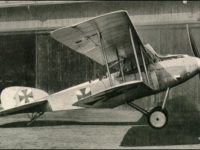The Albatros C.V was a new development of the company Albatros Flugzeugwerke, whereby the construction was not oriented as usual on the predecessor model, but had to be completely redesigned.
Development and construction:
During the development of C.III, the designers were able to fully access the predecessor model C.I and adapt the technical changes.
The development of the C.V, however, a completely new engine should be installed, which meant that the entire construction had to be changed and adapted. Since the new engine was longer and heavier, the hull had to be adjusted first. At the same time, the engine was almost completely clad with sheet metal for the first time, which should prevent damage caused by fire.
The propeller hub was also used to pull sheet metal, which was flush with the fuselage and not only gave the aircraft a clean line but also significantly improved its aerodynamics.
Before the C.V C.IV was already developed. However, since there were only minor changes to the wings on this aircraft, no other aircraft was built apart from the prototype.
Use in the First World War:
1916 began the delivery of the aircraft, which were mainly used on the Western Front together with the C.III.
However, since the new engine was not yet mature and too often failed, the production of the aircraft after 424 machines were discontinued.
The remaining aircraft were used until the end of the war.
Technical specifications:
| Designation: | Albatros C.V |
| Country: | German Empire |
| Typ: | Armed reconnaissance aircraft (Hunting spotter) |
| Length: | 8,95 meters |
| Span: | 12,78 meters |
| Height: | 4,5 meters |
| Mass: | 1.069kg empty |
| Crew: | Max. 2 |
| Engine: | A water-cooled eight-cylinder in-line engine Mercedes D IV, 240 PS starting power |
| Maximum speed: | 170 km/h |
| Reach: | 450 kilometers |
| Armament: | 2 machine guns 7,92mm, up to 70 Kg bombs |
You can find the right literature here:
Fokker Dr I Aces of World War 1 (Aircraft of the Aces)
Undoubtedly the most famous fighter type to see service on either side during World War 1, the Fokker Dr I was a revelation when it entered service on the western front in 1917. Manfred von Richthofens JG 1 circus was the first Jasta to completely re-equip with the new fighter, and in the skilled hands of its numerous aces the Dr I proved a formidable opponent. The Dr I remained in service on the Western Front until replaced by the superior Fokker D VII in May 1918. Just weeks prior to that, however, Germanys leading ace, the great Red Baron, had been killed at the controls of a Dr I.
Friedrichshafen Aircraft of WWI: A Centennial Perspective on Great War Airplanes (Great War Aviation) (Volume 21)

Friedrichshafen Aircraft of WWI: A Centennial Perspective on Great War Airplanes (Great War Aviation) (Volume 21) Paperback – February 16, 2016
This book describes and illustrates the development of Friedrichshafen aircraft of WWI with text, 540 photos, 18 in color, 37 color profiles, production quantities and serial numbers of aircraft, and aircraft dimensions and performance specifications. In addition, there are 26 official SVK drawings and 11 aircraft are illustrated in scale drawings to 1/48 (4) or 1/72 (7) scales. The book has 312 pages and is of interest to aviation historians, enthusiasts, and modelers alike.
German and Austro-Hungarian Aircraft Manufacturers 1908-1918
Much has been written about the British aircraft of the First World War, but little has surfaced about the aircraft of the Axis powers, Germany and Austria. Here, Terry C. Treadwell tells the story of the aircraft from companies such as Fokker, builder of the famous triplane, as fl own by Baron von Richthofen's Flying Circus, AEG, Albatros, Junkers and Hansa. From reconnaissance aircraft to state-of-the-art bombers that could reach London, this is the definitive guide to aircraft of the Axis powers during the First World War. The aircraft are explained in detail and a history of each company is provided, making this an excellent source book for aircraft enthusiasts, model makers and those interested in the air war over the trenches of France and Belgium, as well as further afield in the Italian campaign.
The Zeppelin in Combat: A History of the German Naval Airship Division
The standard reference now revised and expanded. Dr. Robinson has opened up his vast photo archives to enhance this new edition of his classic work. Much of the new photographic material is published here for the first time.
This post is also available in:
 Deutsch (German)
Deutsch (German)  Français (French)
Français (French)  Italiano (Italian)
Italiano (Italian)  简体中文 (Chinese (Simplified))
简体中文 (Chinese (Simplified))  Русский (Russian)
Русский (Russian)  Español (Spanish)
Español (Spanish)  العربية (Arabic)
العربية (Arabic)














